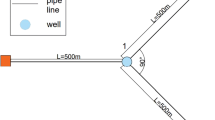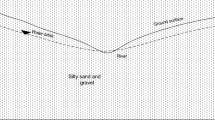Abstract
In this paper, we present a methodology for optimal management of aquifers affected by non-conservative pollutants, by means of application examples. Our multi-criteria approach takes into account: a) Maximization of safe total flowrate from a system of wells; and b) Minimization of pumping cost or of pipe network construction cost. As a preliminary step, we have studied maximization of the total safe well flowrate, without cost restrictions, in order to calculate an upper flowrate bound for all application examples. Then, we have solved two sets of minimization problems, using one of the aforementioned cost criteria in the respective objective function and different values of the required total safe well flowrate as a constraint in all of them. In this way, we have derived a set of Pareto optimal solutions for each problem. We have used the method of genetic algorithms as optimization technique and a moving point code for the simulation of advective pollutant transport. Our paper includes also: a) a discussion of relevant technical details, i.e., moving point arrival at production wells and structure of the penalty function, which is used in the genetic algorithm code; and b) a comparison of the results of the two sets of examples, which shows that the optimal well layouts are rather similar for large total safe flowrate values, while they are quite different for small ones.















Similar content being viewed by others
References
Anders R, Chrysikopoulos CV (2005) Virus fate and transport during artificial recharge with recycled water. Water Resour Res 41(10):W10415. https://doi.org/10.1029/2004WR003419
Bauer-Gottwein P, Schneider R, Davidsen C (2016) Optimizing wellfield operation in a variable power price regime. Groundwater 54:92–103
Bauser G, Franssen H-JH, Stauffer F, Kaiser H-P, Kuhlmann U, Kinzelbach W (2012) A comparison study of two different control criteria for the real-time management of urban groundwater works. J Environ Manag 105:21–29
Dorini GF, Thordarson FÖ, Bauer-Gottwein P, Madsen H, Rosbjerg D, Madsen H (2012) A convex programming framework for optimal and bounded suboptimal well field management. Water Resour Res 48:W06525. https://doi.org/10.1029/2011WR010987
Etsias G (2016) Optimization of groundwater resources management in polluted aquifers. Master thesis, Dept. of Civil Engineering, Aristotle University of Thessaloniki, Greece
Heydari F, Saghafian B, Delavar M (2016) Coupled quantity-quality simulation-optimization model for conjunctive surface-groundwater use. Water Resour Manag 30(12):4381–4397
Holland JH (1975) Adaptation in natural and artificial systems. University of Michigan Press, Ann Arbor
Karamagiola E, Katsifarakis KL (2007) An approximate solution to convective-dispersive mass transport in aquifers. In: Proc. CEMEPE 2007, Skiathos, Greece, pp 2627–2632
Katsifarakis KL, Karpouzos DK (2012) Genetic algorithms and water resources management: an established, yet evolving, relationship. In: Katsifarakis KL (ed) Hydrology, hydraulics and water resources management: a heuristic optimisation approach. WIT Press, Southampton, pp 7–37
Katsifarakis KL, Latinopoulos P (1995) Efficient particle tracking through internal field boundaries in zoned and fractured aquifers. In: Wrobel LC and Latinopoulos P (eds) Water pollution III: modelling, measuring and prediction, Proc 3rd Int. Conf. WATER POLLUTION 95 (Porto Carras, Greece). Computational Mechanics Publications, Southampton, pp 41–48
Katsifarakis KL, Latinopoulos P, Petala Z (1999) Application of a BEM and moving point code to the study of pumped coastal aquifers. In: Brebbia CA, Power H (eds) Boundary elements XXI. WIT Press, Southampton, pp 639–647
Katsifarakis KL, Mouti M, Ntrogkouli K (2009) Optimization of groundwater resources management in polluted aquifers. Global Nest 11(3):283–290
Ketabchi H, Ataie-Ashtiani B (2015) Evolutionary algorithms for the optimal management of coastal groundwater: a comparative study toward future challenges. J Hydrol 520:193–213
Khadem M, Afshar MH (2015) A hybridized GA with LP-LP model for the management of confined groundwater. Groundwater 53(3):485–492
Kontos YN (2013) Optimal management of fractured coastal aquifers with pollution problems. PhD thesis, Dept. of Civil Engineering, Aristotle University of Thessaloniki, Greece (in Greek)
Kontos YN, Katsifarakis KL (2012) Optimization of management of polluted fractured aquifers using genetic algorithms. European Water 40:31–42
Mani A, Tsai FT, Kao S-C, Naz BS, Ashfaq M, Rastogi D (2016) Conjunctive management of surface and groundwater resources under projected future climate change scenarios. J Hydrol 540:397–411
Matiaki MC, Siarkos I, Katsifarakis KL (2016) Numerical modeling of groundwater flow to delineate spring protection zones. The case of Krokos aquifer, Greece. Desalin Water Treat 57(25):11572–11581
Nicklow J, Reed P, Savic D, Dessalegne T, Harrell L, Chan-Hilton A, Karamouz M, Minsker B, Ostfeld A, Singh A, Zechman E (2010) State of the art for genetic algorithms and beyond in water resources planning and management. J Water Resour Plan Manag 136(4):412–432
Ogata A, Banks RB (1961) A solution of the differential equation of longitudinal dispersion in porous media. Prof. paper 411-A, U.S. Geological Survey
Sidiropoulos E, Tolikas P (2008) Genetic algorithms and cellular automata in aquifer management. Appl Math Model 32(4):617–640
Singh A, Panda SN (2013) Optimization and simulation modelling for managing the problems of water resources. Water Resour Manag 27(9):3421–3431
Sreekanth J, Datta B (2011) Coupled simulation-optimization model for coastal aquifer management using genetic programming-based ensemble surrogate models and multiple-realization optimization. Water Resour Res 47(4). https://doi.org/10.1029/2010WR009683
Staboultzidis A-G, Dokou Z, Karatzas GP (2017) Capture zone delineation and protection area mapping in the aquifer of Agia, Crete, Greece. Environ Process. https://doi.org/10.1007/s40710-017-0221-3
Stampouli A (2016) Optimal management of polluted aquifers aiming at maximization of safe total flowrate and minimization of network construction cost. Master thesis, Dept. of Civil Engineering, Aristotle Univesity of Thessaloniki, Greece (in Greek)
Author information
Authors and Affiliations
Corresponding author
Rights and permissions
About this article
Cite this article
Etsias, G., Katsifarakis, K.L. Combining Pumping Flowrate Maximization from Polluted Aquifers with Cost Minimization. Environ. Process. 4, 991–1012 (2017). https://doi.org/10.1007/s40710-017-0264-5
Received:
Accepted:
Published:
Issue Date:
DOI: https://doi.org/10.1007/s40710-017-0264-5




